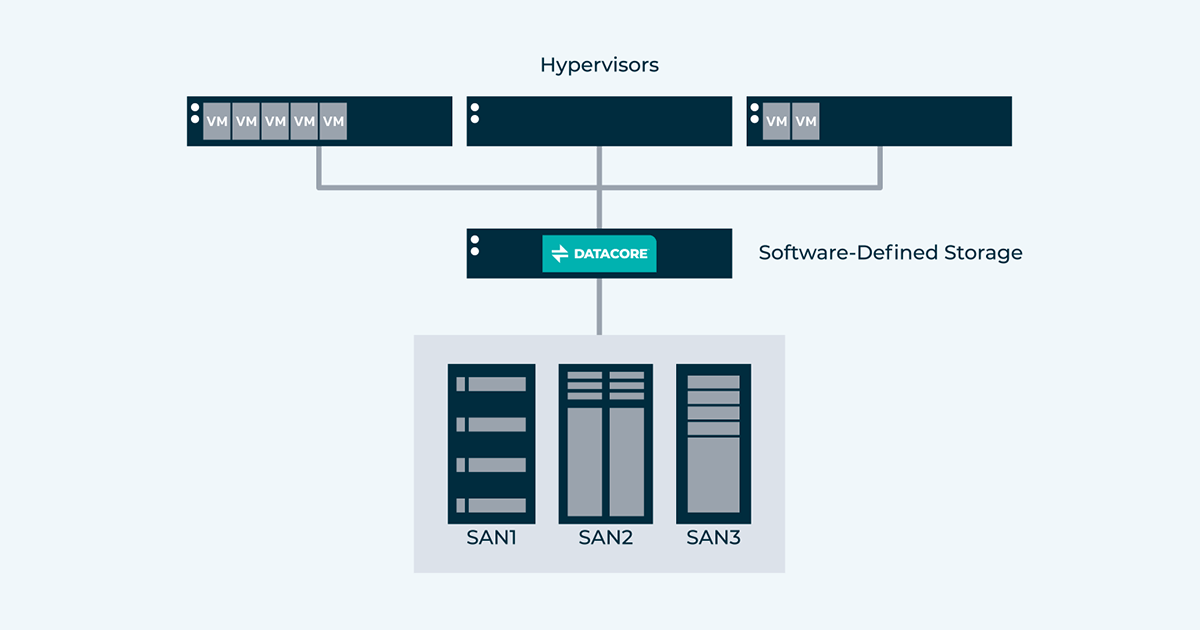Software-Defined storage

Very easy data storing method for hyper-converged infrastructure
VMware Virtual SAN, or VSAN, is a VMware software-based storage solution for Hyperconverged Infrastructure (HCI) that integrates with Hypervisor.
vSAN is a software architecture that integrates compute, network, and shared storage from an x86 virtualized server. Virtual SAN offers flexible and high-performance Shared Storage by clustering flash drives and Hard disk drives (HDDs) connected to the server. This solution uses 32-bit hardware components that are easily scaled to much lower TCOs (up to 50%).

VSAN capabilities
0150% reduction in Ownership costs (TCO)
- Reduction in investment costs (CAPEX) by implementing VSAN on server components without the need for additional equipment as standard and at a lower cost
- Silo hardware Elimination, and Storage service level management automation through virtual machine-based policies
- Improved cost of ownership (Feature: Duplicate and compression data removal, Erasure Coding, and improved automation capabilities)
- server-side investment costs Reduction
- Uninterrupted increase in storage capacity and performance with scalability in both Scale-up and Scale-out
operating costs reduction (OPEX) by simplifying the storage process for virtual machines and shortening the learning curve
02Exceptional performance capabilities
Incredible functionality speed
The hybrid version of Virtual SAN (a combination of Flash and HDD) with very low cost can have the same functionality as an All-Flash Array.
The All-Flash Virtual SAN version can also deliver great performance at an affordable cost.
Virtual SAN all-flash storage architecture can provide up to 100,000 million IOPS with minimum latency and no fluctuations.
03Architecture and functionality
- Highest performance with minimum impact on CPU or memory resources by being placed in the hypervisor kernel and optimizing the I / O data path
- Flash speed level design (compared to other virtualization tools or external equipment)
- Using all-flash architecture for high-level performance and compatibility, and Hybrid architecture to adjust performance and cost
- Performance up to 100,000 million IOPS by all-flash storage architecture and 2.5 million IOPS by Hybrid storage architecture with minimum latency
04Scalable flexibility to expand capacity and performance
- Increasing capacity and performance with linear scalability from 2 hosts to 64 hosts per cluster with a distributed architecture
- Increasing storage capacity and performance independently by adding new drives to existing hosts (Scale-up)
- Increasing storage capacity and performance by adding a new Host to the cluster (Scale-out)
05Management and integration
- Using the vSphere Web Client management console
- Existence of a single and fully integrated interface (vCenter) in storage, computing and network management
- Ability to integrate with other VMware features including vMotion, HA, DRS and FT
- Ability to integrate with other VMware products such as VMware vRealize Automation, vRealize Operations or VMware Site Recovery Manager
06Automation
- Policy-based Provisioning: This policy-based approach automates storage manual tasks and simplifies storage management for virtual machines.
07Practical tips about vSAN
- No need of external storage array with Virtual SAN
- Simple Virtual SAN design for vSphere structure administrators to use
- Policy usage for defining storage features by vSAN
- Virtual SAN design for selecting the best storage for VMs
- Hybrid Virtual SAN speed and function similarity to All-Flash Array
- Virtual SAN (especially Hybrid version), is a cost-effective technology due to its ability to run on standard server hardware
- Resilient or high self-repairing
- Easy to use
- Easy to update and the License transferring possibility in case of moving to a new cluster
- Successful combination of Virtual SAN and Horizon